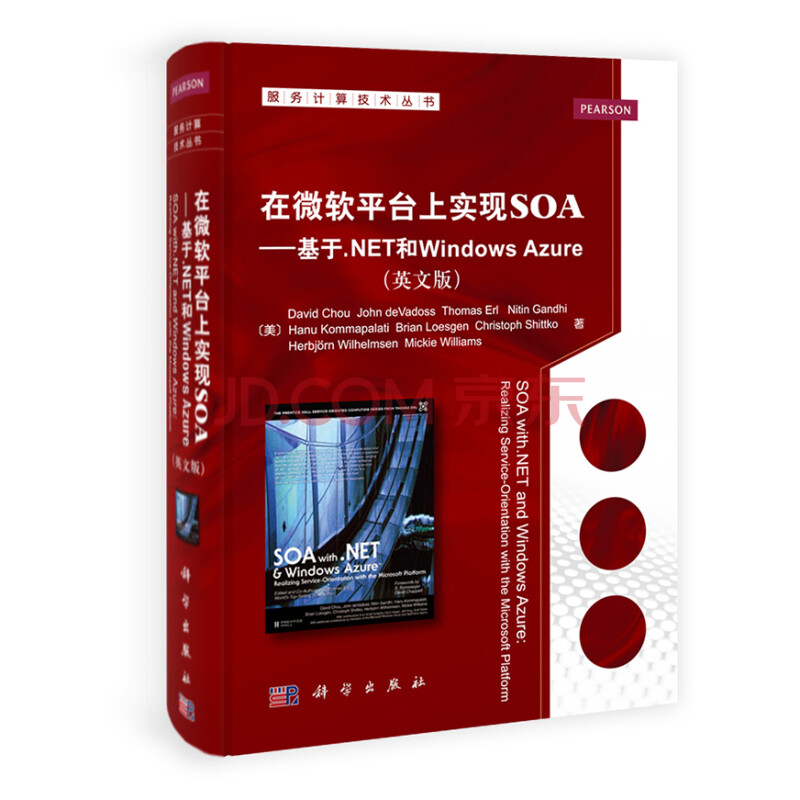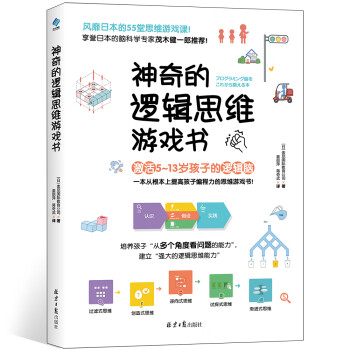热门推荐商品
-
神奇的逻辑思维游戏书 5-13岁提升孩子逻辑思维训练
¥22.50
-
正面管教 修订版 如何不惩罚不娇纵有效管教孩子 育儿百科 最温柔的教养 樊登 早教书
¥19.00
-
一本书读懂中国茶
¥24.90
-
中国国家地理:最好的时光在路上
¥24.90
-
正面管教儿童行为心理学
¥19.00
-
正面管教男孩100招(养育男孩全书)父母的语言话术
¥18.00
-
陪孩子度过7~9岁叛逆期(7-9岁关键养育 叛逆不是孩子的错 男孩女孩自驱型成长)
¥16.30
-
女生呵护指南
¥39.00
-
西尔斯怀孕百科
¥41.50
-
协和医院专家教你吃对不生病:糖尿病吃什么宜忌速查
¥14.90
- 商品名称:服务计算技术丛书:在微软平台上实现SOA·基于.Net和Windows Azure(英文版)
- 商品编号:10981046
编辑推荐
《在微软平台上实现SOA:基于.NET和Windows Azure(英文版)》共分4部分20章,内容包括:在Microsoft平台上的现代服务技术进展,Microsoft企业技术,通用SOA设计模式和原则的工业技术与模型。内容简介
《服务计算技术丛书:在微软平台上实现SOA·基于.Net和Windows Azure(英文版)》主要介绍在。NET和WindowsAzure平台上实现面向服务架构(SOA)的方法。首先综合介绍了在Microsoft平台上的现代服务技术进展,并进一步展现了这些技术提高应用和实现面向服务的潜在可能性;然后深入研究了Microsoft企业技术,如WindowsAzure、WCF、WPF等,以及涉及通用SOA设计模式和原则的工业技术与模型。书中附有大量的编码实例,详细分析了与云计算、编制、企业业务总线平台有关的各种技术架构和实现方式。《服务计算技术丛书:在微软平台上实现SOA·基于.Net和Windows Azure(英文版)》可供SOA领域的软件架构师、高级软件工程师、分析师、应用科研人员等参考学习。
目录
Foreword by S.SomasegarForeword by David Chappell
CHAPTER 1:Introduction
1.1 About this Book
1.2 Objectives of this Book
1.3 Who this Book is For
1.4 What this Book Does Not Cover
1.5 Prerequisite Reading
1.6 How this Book is Organized
Part I:Fundamentals
Chapter 3:SOA Fundamentals
Chapter 4:A Brief History of Legacy .NET Distributed Technologies
Chapter 5:WCF Services
Chapter 6:WCF Extensions
Chapter 7:.NET Enterprise Services Technologies
Chapter 8:Cloud Services with Windows Azure
Part II:Services and Service Composition
Chapter 9:Service-Orientation with .NET Part I:Service Contracts and Interoperability
Chapter 10:Service-Orientation with .NET Part II:Coupling,Abstraction,and Discoverability
Chapter 11:Service-Orientation with .NET Part III:Reusability and Agnostic Service Models
Chapter 12:Service-Orientation with .NET Part IV:Service Composition and Orchestration Basics
Chapter 13:Orchestration Patterns with WF
Chapter 14:Orchestration Patterns with BizTalk Server
Part III:Infrastructure and Architecture
Chapter 15:Enterprise Service Bus with BizTalk Server and Windows Azure
Chapter 16:Windows Azure Platform AppFabric Service Bus
Chapter 17:SOA Security with .NET and Windows Azure
Chapter 18:Service-Oriented Presentation Layers with .NET
Chapter 19:Service Performance Optimization
Chapter 20:SOA Metrics with BAM
Part IV:Appendices
Appendix A:Case Study Conclusion
Appendix B:Industry Standards Reference
Appendix C:Service-Orientation Principles Reference
Appendix D:SOA Design Patterns Reference
Appendix E:The Annotated SOA Manifesto
Appendix F:Additional Resources
1.7 How Principles and Patterns are Used in this Book
Sources
Reference Notation
1.8 Symbols,Figures,and Style Conventions
Symbol Legend
How Color is Used
Additional Information
Updates,Errata,and Resources(www.soabooks.com)
Master Glossary(www.soaglossary.com)
Referenced Specifications(www.soaspecs.com)
SOASchool.comTM SOA Certified Professional(SOACP)
The SOA Magazine(www.soamag.com)
Notification Service
CHAPTER 2:Case Study Background
2.1 How Case Studies Are Used
2.2 Case Study Background #1:Standard Mold
History
Technical Infrastructure
Business Goals and Obstacles
2.3 Case Study Background #2:Superior Stamping
History
Technical Infrastructure
Business Goals and Obstacles
PART I:FUNDAMENTALS
CHAPTER 3:SOA Fundamentals
3.1 Basic SOA Terminology
Service-Oriented Computing
Service-Orientation
Service-Oriented Architecture(SOA)
Services
Services as Components
Services as Web Services
Services as REST Services
Service Models
Agnostic Logic and Non-Agnostic Logic
Service Composition
Service Inventory
Service-Oriented Analysis
Service Candidate
Service-Oriented Design
Service Contract
Service-Related Granularity
SOA Design Patterns
3.2 Service-Oriented Computing Goals
Increased Intrinsic Interoperability
Increased Federation
Increased Vendor Diversification Options
Increased Business and Technology Domain Alignment
3.3 Further Reading
CHAPTER 4:A Brief History of Legacy .NET Distributed Technologies
4.1 Distributed Computing 101
Client-Server
Distributed Architecture
Service-Oriented Architecture
4.2 .NET Enterprise Services
It All Began with COM(and DCOM)
COM+ Services
.NET Assemblies
Distributed Transaction Coordinator
.NET Enterprise Services and Service-Orientation
4.3 .NET Remoting
.NET Remoting Architecture
Serializable Classes
Remotable Classes
Ordinary Classes
Hosting .NET Remoting Components
Windows Service
IIS Hosting Under ASP.NET
Hosting a .NET Remoting Component in a Console Application
.NET COM+ Services
.NET Remoting Configurations
Activation Types
Message Formats
Communication Protocols
Object Lifetime Management
.NET Remoting and Service-Orientation
4.4 Microsoft Messaging Queue(MSMQ)
The Queues
Sending and Receiving Messages
MSMQ and Service-Orientation
4.5 System.Transactions
Distributed Resource Transactions
Explicit and Implicit Programming Models
Ambient Transactions
4.6 Web Services(ASMX and WSE)
XML Web Services(ASMX)
The WebService Attribute
The WebMethod Attribute
Web Service Enhancements(WSE)
4.7 REST Service Processing with IHttpHandler
CHAPTER 5:WCF Services
5.1 Overview
5.2 Service Contracts with WCF
WCF Terminology
WCF Service Contract
Interface Contract
Operation Contract
Data Contract
Message Contract
Service Endpoint
The ServiceContract and OperationContract Attributes
Data Models and the DataContract Attribute
Messaging and the MessageContract Attribute
Service Endpoints and the endpoint Element
Address
Bindings
Contract
REST Service Classes and Attributes
The WebGet Attribute
The WebInvoke Attribute
WCF UriTemplate Attribute
Faults and the FaultContract Attribute
MEX Endpoints
Versioning Considerations
5.3 Service Implementation with WCF
Behaviors
Instancing
A Sample Implementation
5.4 Service Hosting with WCF
Self-Hosted Services
Managed Windows Services
IIS Process Boundary
Windows Activation Services(WAS)
Hosting REST Services
5.5 Service Consumers with WCF
Using the Service Metadata Tool
Writing the Proxy Class for a Service
Using the ChannelFactory Class
CHAPTER 6:WCF Extensions
6.1 WCF Security
Security Modes
Authorization
Federated Identity
6.2 WCF Transactions
Operation Attributes for Transactions
TransactionScopeRequired
TransactionAutoComplete
TransactionFlow
Service Attributes for Transactions
TransactionIsolationLevel
TransactionAutoCompleteOnSessionClose
TransactionTimeout
Durable Services
6.3 WCF Router
The RoutingService Class
Routing Contracts
Routing Configuration
Step 1:Define Endpoints
Step 2:Configure Service Behavior
Step 3:Enumerate Target Endpoints
Step 4:Define Message Filters
Step 5:Create a Filter Table
Fault Tolerance
6.4 WCF Discovery
Discovery Modes
Locating a Service Ad Hoc
Sending and Receiving Service Announcements
Discovery Proxies for Managed Discovery
Discovering from a Discovery Proxy
Implicit Service Discovery
6.5 WCF Extensibility
WCF Layers
Layered Extensibility
Channel Layer Extensibility
6.6 WCF Management Tools
Administration
Troubleshooting
Logging Messages
CHAPTER 7:.NET Enterprise Services Technologies
7.1 SQL Server
Native XML Web Services Support
Service Broker(SSB)
Query Notification
XML Support in SQL Server
7.2 Windows Workflow Foundation(WF)
WF Architecture
Workflows
Sequential Workflows
State Machine Workflows
Workflow Designer
Workflow Persistence(with WF)
Communicating with the Host Container
Activities
Workflow Runtime Environment
WF Programming Model
Passing Parameters into a Workflow Instance
Returning Parameters from a Workflow Instance
Workflow-Enabled Services
Versioning Orchestrations
WF Extensibility
Business Rules
7.3 Application Blocks and Software Factories
Application Blocks
Software Factories
Guidance Toolkits
Web Services Software Factory
7.4 Windows Server AppFabric
Configurable Hosting Environment
Workflow Persistence(with AppFabric)
In-Memory Application Cache Platform
Manageability Extensions
Application Server Event Collector
7.5 BizTalk Server
BizTalk Server Architecture
Messaging
Pipelines
Pipeline Components
Ports and Locations
Adapters
Context Properties
Itineraries
Unified Exception Management
CHAPTER 8:Cloud Services with Windows Azure
8.1 Cloud Computing 101
Cloud Deployment Models
Public Cloud
Private Cloud
Community Cloud
Other Deployment Models
The Intercloud(Cloud of Clouds)
Deployment Models and Windows Azure
Service Delivery Models
Infrastructure-as-a-Service(IaaS)
Platform-as-a-Service(PaaS)
Software-as-a-Service(SaaS)
Other Delivery Models
IaaS vsPaaS
8.2 Windows Azure Platform Overview
Windows Azure(Application Container)
SQL Azure
Windows Azure Platform AppFabric
8.3 Windows Azure Roles
Web Roles and Worker Roles
Virtual Machines
Input Endpoints
Inter-Role Communication
8.4 Hello World in Windows Azure
1.Create a Cloud Service Project
2.Choose an ASP.NET Web Role
3.Create the Solution
4.Instantiate the Service
8.5 A Web Service in Windows Azure
1.Create a Host Service and Storage Service
2.Create and Deploy a Service Package
3.Promote the Service to Production
8.6 A REST Service in Windows Azure
REST Service Addressing
Creating a Windows Azure REST Service
8.7 Windows Azure Storage
Tables
Entities and Properties
Data Access
Queues
Blobs
Block Blobs
Page Blobs
Windows Azure Drive
PART II:SERVICES AND SERVICE COMPOSITION
CHAPTER 9:Service-Orientation with .NET Part I:Service Contracts and Interoperability
9.1 Standardized Service Contract
Contract-First
1.Create or Reuse Data Contract
2.Create Message Contract
3.Create Interface Contract
Standardized Service Contract and Patterns
9.2 Canonical Schema
Creating Schemas with Visual Studio
Generating .NET Types
Using the DataContract Library
9.3 Data Model Transformation
Object-to-Object
LINQ-to-XML
XSLT Transformation
9.4 Canonical Protocol
Web Service
REST Service
Component
Another WCF Option:Named Pipes
Dual Protocols with WCF
9.5 Canonical Expression
Service Naming Conventions
Service Capability Naming Conventions
CHAPTER 10:Service-Orientation with .NET Part II:Coupling,Abstraction,and iscoverability
10.1 Service Loose Coupling
Service Loose Coupling and Patterns
10.2 Decoupled Contract
WSDL-First
Generating Service Code Using Svcutil
Generating WCF Service Code Using WSCF.blue
Generating ASMX Service Code Using WSCF.classic
10.3 Service Facade
10.4 Concurrent Contracts
10.5 Service Loose Coupling and Service Capability Granularity
10.6 Service Abstraction
10.7 Validation Abstraction
10.8 Exception Shielding
10.9 Service Discoverability
In-line Documentation
REST and Hypermedia
Service Profiles
10.10 Metadata Centralization
CHAPTER 11:Service-Orientation with .NET Part III:Reusability and Agnostic Service Models
11.1 Service Reusability and the Separation of Concerns
Functional Decomposition
Service Encapsulation
Agnostic Context
Agnostic Capability
Utility Abstraction
Entity Abstraction
The Inventory Analysis Cycle
Additional Design Considerations
11.2 Case Study Example:Utility Abstraction with a .NET Web Service
11.3 Case Study Example:Entity Abstraction with a .NET REST Service
CHAPTER 12:Service-Orientation with .NET Part IV:Service Composition and Orchestration Basics
12.1 Service Composition 101
Service-Orientation and Service Composition
Service Composability(PSD)
Capability Composition and Capability Recomposition
Capability Composition
Capability Recomposition
Composition Roles
Service Layers
Non-Agnostic Context
Process Abstraction and Task Services
12.2 Orchestration
Process Abstraction,Process Centralization,and Orchestrated Task Services
Process Centralization and Tools
Process Abstraction and WS-BPEL
State Repository and Compensating Service Transaction
State Repository with .NET
Compensating Service Transaction
Other Patterns
Microsoft Orchestration Platforms:WF and BizTalk Server
CHAPTER 13:Orchestration Patterns with WF
13.1 Process Abstraction and Orchestrated Task Services
A Brief History of WF Service Contract Support
Publishing WF Workflows as Web Services and Activities
Workflows Published as ASMX Services
Workflows Published via WCF 3.5 Activities
Workflows Published via WCF 4.0 Activities
Workflows Published via ExternalDataExchange Services
WS-I BasicProfile Support
Publishing WF Workflows as REST Services
JSON Encoding
Send and Receive Activity Configuration
Orchestrated Task Services with REST and WF 4.0
13.2 Process Centralization
Centralized Process Maintenance
WS-BPEL Support
13.3 State Repository
SQL Persistence Service and Scaling Out in WF 3.0
SQL Persistence Service and Scaling Out in WF 4
13.4 Compensating Service Transaction
Creating Compensations
Triggering Compensations
13.5 Case Study Example
CHAPTER 14:Orchestration Patterns with BizTalk Server
14.1 Process Abstraction and Orchestrated Task Services
Orchestrated Task Service Contracts
WS-* Support
Case Study Example
14.2 Process Centralization
Centralized Process Maintenance
WS-BPEL Support
Exporting BizTalk Orchestrations to WS-BPEL
Importing WS-BPEL Processes into BizTalk
14.3 State Repository
14.4 Compensating Service Transaction
Case Study Example
PART III:INFRASTRUCTURE AND ARCHITECTURE
CHAPTER 15:Enterprise Service Bus with BizTalk Server and Windows Azure
15.1 Microsoft and the ESB
15.2 Integration with BizTalk
Application Integration 101
The BizTalk Hub-Bus Model
15.3 The ESB Toolkit
Itineraries
Itineraries Types
The Itinerary Lifecycle
Resolvers
Adapter Providers
WCF-Custom and REST Services
15.4 Distributed and Scalable ESB Architecture
Configuring for High-Availability
Techniques for Scaling
Distributed ESBs
15.5 Cloud-Enabling the ESB with Windows Azure
Receiving Messages from Azure's AppFabric Service Bus
Sending Messages to Azure's AppFabric Service Bus
15.6 Governance Considerations
SLA Enforcement
Monitoring
Preparing Project Teams
15.7 Mapping the Microsoft Platform to the Enterprise Service Bus Pattern
CHAPTER 16:Windows Azure Platform AppFabric Service Bus
16.1 Introducing the Service Bus
Connectivity Fabric
Message Buffers
Service Registry
16.2 Service Bus and REST
REST-Based Service Design
REST-Based Service Consumer Design
Message Buffers and REST
16.3 Service Bus Connectivity Models
Eventing
Service Remoting
Tunneling
16.4 Working with Windows Azure Platform AppFabric Service Bus
Setting up the AppFabric Service Bus
Defining a REST-Based Service Bus Contract
Creating the Service Bus Message Buffer
CHAPTER 17:SOA Security with .NET and Windows Azure
17.1 Authentication and Authorization with WCF
Direct and Brokered Authentication
Direct Authentication
Brokered Authentication
Authentication Patterns in WCF
Role-Based Authorization
Authorization Roles in WCF
Authorizing Operations with Roles
Claims-Based Authorization
Claims Processing in WCF
Implementing Claims-Based Authorization
Access Control in Windows Azure
Designing Custom Claims
Case Study Example
17.2 Windows Identity Foundation(WIF)
Digital Identity
The Identity Metasystem
Windows Cardspace
Active Directory Federation Services(ADFS)
WIF Programming Model
WCF Integration
Programming Windows Cardspace
Developing a Relying Party
Developing an Identity Provider
17.3 Windows Azure Security
Cloud Computing Security 101
Cross-Domain Access Control
Hybrid Cloud Security
Inter-Organization Service Composition Security
External Identity Providers
Claims-Based Access Control,As-A-Service
Windows Azure Platform AppFabric Access Control Overview
Access Control Step-by-Step
Access Control and REST
Access Control Service Authorization Scenarios
Hybrid Cloud Authorization Model
Public Cloud Authorization Model
Cloud-to-Cloud Authorization Model
Case Study Example
CHAPTER 18:Service-Oriented Presentation Layers with .NET
18.1 Windows Presentation Foundation and the Prism Library
Shell
Views
View Discovery versus View Injection
Regions
Modules
Shared Services
18.2 Design Patterns for Presentation Logic
User Interface Patterns
Composite View [CJP]
Command [DP]
UI Mediator
Separated Presentation
Modularity Patterns
Separated Interface [PEA]
Plug-In [PEA]
Event Aggregator [PEA]
Inversion of Control [DP]
Dependency Injection [PEA]
Service Locator [CJP]
18.3 A Simple Service-Oriented User Interface
Creating the Project
Dynamically Loading Modules
CHAPTER 19:Service Performance Optimization
19.1 Overview
Optimization Areas
Service Implementation Processing
Service Framework Processing
Wire Transmission Processing
19.2 Service Performance Optimization Techniques
Caching to Avoid Costly Processing
Intermediary
Service Container
Service Proxy
Caching Utility Service
Comparing Caching Techniques
Cache Implementation Technologies
Computing Cache Keys
Case Study Example
Method 1
Method 2
Caching REST Responses
Monitoring Cache Efficiency
Reducing Resource Contention
Request Throttling
Throttling With WCF
Case Study Example
Request Throttling with BizTalk Server
Coarse-Grained Service Contracts
Case Study Example
Selecting Application Containers
Performance Policies
Case Study Example
REST Service Message Sizes
Hardware Encryption
Transport Encryption
Message Encryption
Custom Encryption Solution
High Performance Transport
Case Study Example
MTOM Encoding
Case Study Example
Performance Considerations for Service Contract Design
Case Study Example
Impact on Service-Orientation Principles
19.3 Service Composition Performance Optimization Techniques
Transformation Avoidance and Caching
Asynchronous Interactions
Parallelize Where Possible
Parallel Activity in WF
Parallel Execution in BizTalk Server
Replicator Activity in WF
Consider Co-Hosting When Necessary
Compose High Performance Services
Impact on Service-Orientation Principles
CHAPTER 20:SOA Metrics with BAM
20.1 SOA Metric Types
20.2 Introducing BizTalk BAM
BizTalk and BAM
BAM Solution Architecture
The BAM Management Utility
The Tracking Profile Editor(TPE)
Real-Time vs Scheduled Aggregations
20.3 Activities and Views
Roles-based Views for Service Governance
Creating Views
20.4 BAM APIs
Event Streams
DirectEventStream(DES)
BufferedEventStream(BES)
OrchestrationEventStream(OES)
IPipelineContext Interface
Abstracted APIs for Service Metrics
Metrics for Service Compositions
WCF and WF Interceptors
Notifications
Rapid Prototyping
20.5 Managing BAM
Database Outages
Security
Scripting Deployment
Reporting
Case Study Example
PART IV:APPENDICES
APPENDIX A:Case Study Conclusion
APPENDIX B:Industry Standards Reference
APPENDIX C:Service-Orientation Principles Reference
APPENDIX D:SOA Design Patterns Reference
APPENDIX E:The Annotated SOA Manifesto
The Annotated SOA Manifesto
APPENDIX F:Additional Resources
Consuming Services with WCF
Introduction
Cleaning Up Resources
The Proper Disposal and Closing of an ICommunicationObject
The ICommunicationObject.Close()Method
The ICommunicationObject.Abort()Method
Abort()versus Close()
IDisposable for Cleaning Up Resources
IDisposable and Its Relation to ClientBase and ChannelFactory
Cleaning Up Resources with the Using Block
Cleaning Up Resources with the Try-Catch-Finally-Abort Pattern
Handling Exceptions and Cleaning Up Resources with the Try-Close-Catch-Abort Pattern
Cleaning Up Resources in a Convenient Way
How to Handle Connections when Consuming Services Using WCF
Conclusion
About the Authors
David Chou
John deVadoss
Thomas Erl
Nitin Gandhi
Hanu Kommalapati
Brian Loesgen
Christoph Schittko
Herbjorn Wilhelmsen
Mickey Williams
About the Contributors
Scott Golightly
Darryl Hogan
Kris Horrocks
Jeff King
Scott Seely
About the Foreword Contributors
David Chappell
S.Somasegar
Index


















 沪公网安备 31010402003631号
沪公网安备 31010402003631号